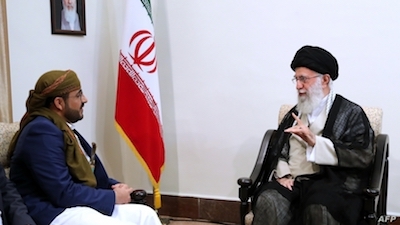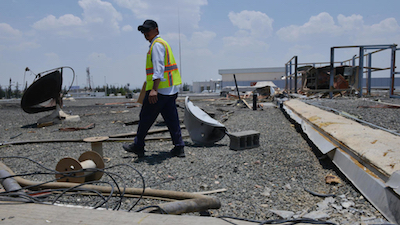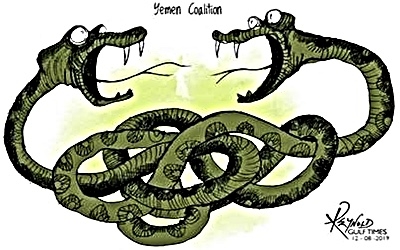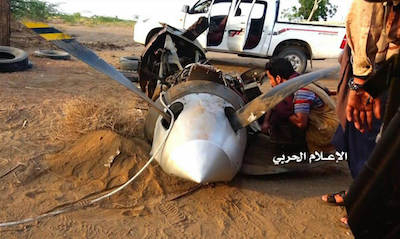by Jonathan Spyer
The Saudi-led effort to crush the rebellion by the Iran-aligned Ansar Allah (Houthi) movement in Yemen is into its fifth year. The operation has largely run aground. There is now a UN-sponsored truce over control of the contested port of Hodeidah, in the west of the country.
Over 10,000 people have died since the Saudi and Emirati intervention began in March 2015. Saudi and Emirati-led forces succeeded in preventing the strategic disaster of a Houthi capture of Bab al-Mandeb, a choke point between the Red Sea and the Gulf of Aden. But the Houthis remain in control of the Yemeni capital, Sanaa, a considerable part of the coast, and the main urban centers of the country.
The anti-Houthi forces, meanwhile, have now turned on one another, with the UAE-backed Southern Transitional Council challenging Saudi-supported forces aligned with the official government led by Abd-Rabbu Mansour Hadi. The STC fighters now control the port of Aden, with the prospect for further clashes between the sides.
Anti-Houthi forces in Yemen have now turned on one another.
While Riyadh would like to see the total defeat of the Houthis (but has proved unable to secure this), Abu Dhabi's focus is on securing Red Sea shipping lines and restricting the influence of Sunni Islamist forces in the areas under government control.
With the front lines stalemated, meanwhile, there are signs that the Houthis are consolidating their grip on their own areas and formalizing their rule. This is of concern to Israel.
The Houthi area of control is an integral part of the Iranian sphere in the region, and is therefore a component part in the alliance against which Jerusalem is currently engaged in a secret and not-so-secret war.
The Houthis are consolidating and formalizing their grip on their own areas.
Houthi consolidation is taking a number of forms.
On the diplomatic level, the Houthis have begun to behave like an official government, appointing their first ambassadors. On August 17, Abdul Malik al-Houthi, the movement's leader, announced his intention to reach out to "friendly countries, and in particular the Islamic Republic of Iran."
On August 18, a decree issued in the name of the "Republic of Yemen" was announced from Sanaa, appointing "Ibrahim Mohammed Mohammed al-Dailami as extraordinary and plenipotentiary ambassador of the Republic of Yemen to the Islamic Republic of Iran."
Houthi spokesman Mohammed Abdul-Salam (left) met with Iranian Supreme Leader Ali Khamenei in Tehran last month.
 This announcement followed swiftly on from a visit by Houthi spokesman Mohammed Abdul-Salam to Tehran, where he met with Supreme Leader Ali Khamenei and other officials. Khamenei reiterated Iran's support for the Houthis, whom he described as the "mujahideen" in Yemen, during the visit.
This announcement followed swiftly on from a visit by Houthi spokesman Mohammed Abdul-Salam to Tehran, where he met with Supreme Leader Ali Khamenei and other officials. Khamenei reiterated Iran's support for the Houthis, whom he described as the "mujahideen" in Yemen, during the visit.
This appointment formalizes the Iranian-Houthi connection, and appears to consolidate a relationship which for pragmatic reasons both parties had seen fit to deny or minimize in the past. It reflects an increasing boldness and openness on the part of both Tehran and Ansar Allah.
This growing diplomatic confidence, meanwhile, derives from the advancing military strength and confidence of the Houthis. Thanks to the help of the Iranian Revolutionary Guards Corps, with the close involvement of Lebanese Hezbollah members, the Houthis are no longer the ragtag guerrilla force that seized Sanaa in early 2015.
Wreckage of a US MQ-9 Reaper drone shot down by Houthi rebels over Hodeidah in June 2019.
Rather, they (or equally possibly, IRGC or Hezbollah men working alongside them) are now capable of operating air defense systems, including the Fater-1 and Thaqib-1. Utilizing these systems, the Houthis claim to have shot down a state-of-the-art US MQ-9 Reaper drone over Hodeidah on June 7.
The offensive capacities of the Houthis are similarly moving rapidly ahead. The Houthis have carried out a series of armed drone and ballistic missile attacks on targets deep inside Saudi Arabia in recent weeks.
On August 16, the Houthis launched an armed drone attack at the Shaybah oil field. The Shaybah field is located close to the Saudi-UAE border, more than 1,000 kilometers from the Houthi area of control in Yemen. On August 26, they fired 10 Badr-1 ballistic missiles at Jizan airport in Saudi Arabia (the Saudis claim to have intercepted six of these). A day later, an additional drone attack took place against a military target in the Riyadh area. On September 3, Arab coalition aircraft destroyed a Houthi drone launched toward Saudi Arabia from Amran province in Yemen.
A worker at Abha airport in Saudi Arabia inspects damage from a Houthi missile attack in June 2019.
 This ongoing series of attacks is testimony to the military confidence of the Houthis. They are no longer facing an existential threat to their rule. Rather, firmly ensconced in their area of control, they are coming to form a key part in the broader Iran-led regional bloc.
This ongoing series of attacks is testimony to the military confidence of the Houthis. They are no longer facing an existential threat to their rule. Rather, firmly ensconced in their area of control, they are coming to form a key part in the broader Iran-led regional bloc.
Israeli officials express doubt regarding the steeply rising curve of the movement's technical abilities. Rather, they point to the useful cover the Houthis' banner offers for activities probably carried out directly by Iranian personnel or cadres from more capable Iranian proxies such as Lebanese Hezbollah.
The Houthis' consolidation is also reflected in the process of institution building they have begun in the part of Yemen they control. On September 2, the Saba News Agency, which is associated with the Houthis, announced the establishment by the Supreme Political Council of the Houthis of the Security and Intelligence Service, a new intelligence body which will be the sole such entity permitted to operate in Houthi-controlled Yemen. The existing National Security Agency and Central Political Security Agency are to be disbanded.
It is a perhaps poignant (but unsurprising) comment on the state of governance in the Arab world that the first formal body created by an emergent new power should be the secret and political police service. In any case, the establishment of the new force by Ansar Allah is testimony to its growing consolidation and sense of permanence.
Houthi-controlled areas of Yemen are becoming a new platform for the projection of Iranian power.
From Israel's point of view, the growing strength of the Houthis, and the evidence of direct IRGC/Hezbollah involvement with them, raise the possibility that the broad front on which Jerusalem's forces are already engaged (across Lebanon, Syria and Iraq) may imminently extend also to Yemen.
The latter is no longer an isolated front in which Israel's de facto Gulf partners are engaging against a weaker and peripheral Iranian ally. Rather, the Houthi-controlled part of Yemen appears set to emerge as an additional platform for the projection of Iranian power.
Currently, that power projection is directed on land against Saudi Arabia. But of greater regional significance is the possibility that Iranian weaponry smuggled into the Houthi-controlled part of Yemen could subsequently be used to attack shipping making its way up the Red Sea toward the Suez Canal. The Houthi-controlled region, after all, includes a considerable section of Yemen's Red Sea coast.
Such a capability would form an additional useful tool of pressure for Iran in the region-wide contest currently taking place. And as things currently stand, Israel may well be the only power both able and willing to frustrate the Iranian effort to establish this capability.
The rise and consolidation of the Houthis may seem to be taking place at a considerable distance from Jerusalem. But as things currently stand, Yemen is both Israel's and Iran's backyard. As a result, it constitutes an additional key arena in the contest currently playing out between them.


No comments:
Post a Comment